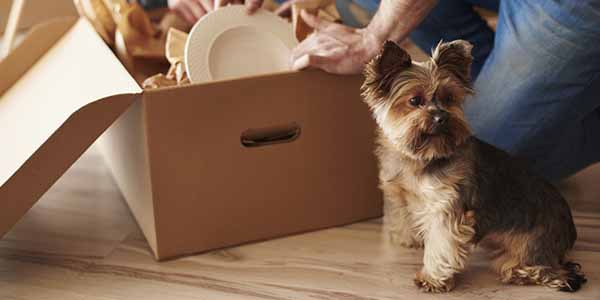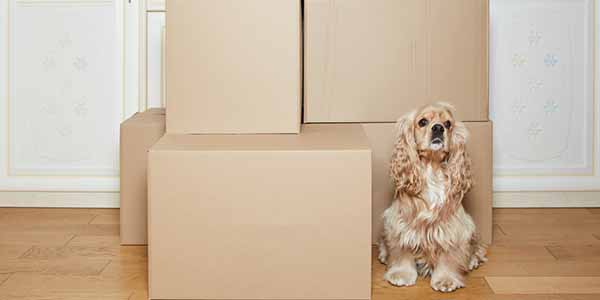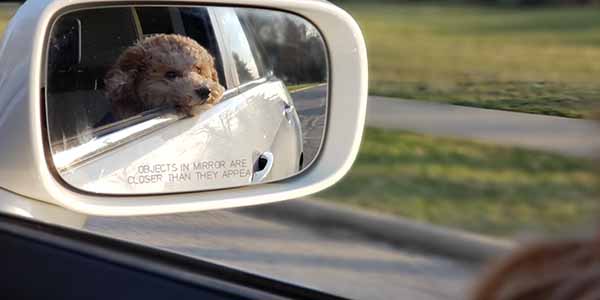Moving With a Dog

Moving is a stressful experience, especially for your dog. They won’t understand what is happening, but they will know that something big is happening. Dog’s can pick up on your energy, so the anxiety and stress you feel from your move will affect your dog. It’s up to you to help them adjust to the move and alleviate the stress of moving. While moving with a dog can be difficult, knowing what steps to take can help make it easier for them and you.

Before the Move:
Expose your dog to the moving supplies
Before you begin to pack, start to set out your moving supplies. This will allow your dog to become accustomed to having boxes and other materials in the house.
Simulate the move
Do a short run-through of your move before it actually happens. If you are driving to your new home, load your dog into your car and drive around for a bit. Use a crate for this drive if you plan to use one for the move.
Stick to a routine
The chaos of moving will make your dog anxious. Don’t let the long hours of moving and stress of packing keep you from maintaining your dog’s routine. Stay consistent in feeding times, walks, and taking them out to use the bathroom.
Make sure they have an ID tag and are microchipped
Before moving, make sure your dog has ID tags or is microchipped. In the chance that they take off at any point, you’ll have an easier time finding them.
Allow plenty of time for exercise
Exercise is essential for your dog’s mental wellness. It’s essential they get plenty of exercise during this stressful time. Being able to run around daily will help keep their stress levels down.
Keep them mentally stimulated
While you are preparing for your move, you probably won’t be able to give your dog as much attention as you usually do. Make sure to have toys and activities to keep them mentally stimulated to keep them occupied. This helps keep their mind off the move.
Designate a “safe space”
Choose a room in your house to pack up first. Once it’s packed up, place toys, treats, and a comfy bed in this room for your dog. Keep this room free of all moving-related things to create a “safe space” for your dog that is free of stressors.
Let them inspect their crate
If you plan on putting your dog in a crate when moving, place it out for them to inspect in the days leading up to the move. Put treats, toys, and blankets inside to make it a comfortable place for your dog.
During the Move:
Look into anti-anxiety options
If you think your dog will be anxious during the trip to your new home, you have several options. You can look into anti-anxiety treats. Or, you can ask your vet to prescribe anti-anxiety medication. There are also calming collars or shirts for your dog that you can try out.
Have them stay elsewhere
On moving day, make arrangements for your dog to stay somewhere else. Once everything is packed up, and all the craziness is over, you can pick up your dog and prepare for your journey.
Cover the crate
If you are using a crate, cover it with a light blanket for the first few hours of your trip to reduce stimuli. Put a few toys in the crate to keep your dog occupied. Once they seem settled in, you can remove the blanket.
Reduce meal sizes
In the day leading up to the move, reduce the portion size of your dog’s meals. This will help avoid an upset stomach caused by motion sickness.
Speak in a calm, soothing manner
While in transit to your new home, speak to your dog in a calm, soothing manner. Hearing your voice will help them settle down and feel more comfortable.
After the Move:
Inspect and dog-proof your new home
Before letting your dog loose in your new home, do a quick sweep. Look for things like loose electrical cables and mouse or bug traps.
Let your dog investigate
Allow your dog to investigate your new space. Take them for a walk in the backyard and around their new neighborhood. Let them run around their new home and get accustomed to the layout.
Keep schedule consistent
As you begin to move it, continue to keep your dog’s schedule consistent. Set timers for feeding, walks, and letting them out to go to the bathroom.
Stage the house familiarly
If you can, stage your new home similarly to your old one. Even if you plan to move everything around later, creating a familiar space will help your dog adjust. Once you’re all settled in, you can begin moving furniture around.
By following all of these steps, you’ll have an easier time moving with your dog. All dogs have different personalities, so it’s important to pay attention to how yours adjust to the move. Be patient with them and give them the support they need. They can’t communicate their feelings as you can, so it’s up to you to take the time to give them the attention they need.
For more moving tips, sign up for our monthly blog newsletter.







